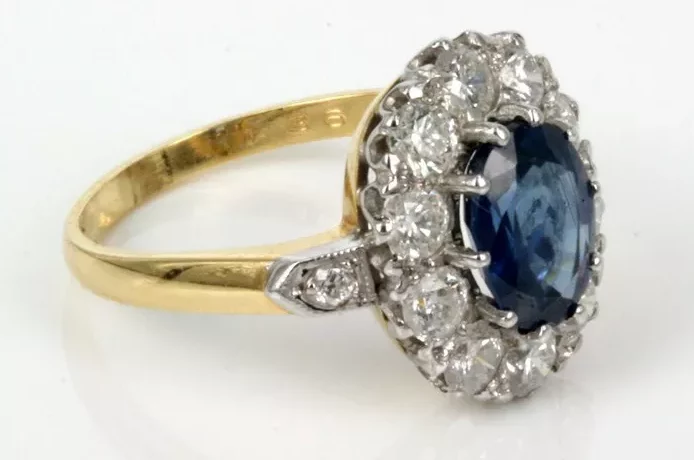Sapphires, with their mesmerizing deep blue hues, have long captivated jewelry enthusiasts and collectors alike. As one of the most coveted gemstones, sapphires hold significant value, both sentimentally and monetarily. However, in a market flooded with imitations and synthetics, distinguishing a genuine sapphire from a fake can be challenging. Whether you’re purchasing a sapphire for an engagement ring, investment, or simply admiring its beauty, ensuring its authenticity is paramount. In this guide, we will delve into various methods to authenticate sapphires, empowering you to make informed decisions and safeguard your investment.
Visual Inspection:
The first step in verifying the authenticity of a sapphire is through visual inspection. Under good lighting conditions, genuine sapphires exhibit exceptional depth and brilliance. Their natural color should be vibrant and vivid, with no signs of dullness or cloudiness. Hold the sapphire up to a light source and observe how it interacts with the light. Authentic sapphires typically display a rich, intense color that seems to emanate from within the stone.
Another aspect to consider during visual inspection is the presence of flaws and inclusions. Using a jeweler’s magnifying glass with at least 10x magnification, carefully examine the surface of the sapphire. Natural sapphires often contain tiny specks, known as inclusions, and other blemishes that are indicative of their natural origin. These imperfections, although they may seem minor, contribute to the gemstone’s uniqueness and authenticity. In contrast, lab-created or synthetic sapphires are typically devoid of such inclusions, appearing flawless under magnification.
Breath Test:
A simple yet effective method to distinguish between natural and synthetic sapphires is the breath test. By breathing on the surface of the sapphire, you can observe how quickly the fog dissipates. Natural gems tend to clear up within one or two seconds, as the moisture evaporates from the surface. In contrast, lab-created sapphires may take longer, closer to five seconds, to clear up completely. This difference in fogging time is attributed to variations in the thermal conductivity between natural and synthetic materials.
It’s important to note that while the breath test can provide a preliminary indication of authenticity, it should not be relied upon as the sole method of verification. Other factors, such as visual inspection and professional certification, are essential for a comprehensive assessment of the sapphire’s authenticity.
Certification:
For a definitive assessment of a sapphire’s authenticity, obtaining certification from reputable gemological laboratories is highly recommended. Gemologists employ advanced techniques, including refractometers and magnification Polaris scopes, to analyze the gemstone’s properties and determine its origin. A certified gemstone comes with a detailed report that verifies its authenticity, outlines any treatments it may have undergone, and provides valuable information about its quality and characteristics.
Having your sapphire certified not only ensures its authenticity but also enhances its value and marketability. Whether you’re purchasing a sapphire or own an heirloom piece, obtaining certification offers peace of mind and transparency in the transaction. Additionally, for vintage or antique sapphires passed down through generations, certification can validate their provenance and historical significance.
Scratch Test:
Sapphires are renowned for their exceptional hardness, ranking 9 on the Mohs scale of mineral hardness. This remarkable durability makes them highly resistant to scratches and abrasions, distinguishing them from softer gemstones and imitations. To conduct a scratch test, simply attempt to scratch the surface of the sapphire with a common household item such as a key or coin. If the sapphire remains unscathed and shows no signs of scratching, it is likely genuine.
However, it’s important to exercise caution when performing a scratch test, as excessive force or pressure can damage even the hardest gemstones. Additionally, while the scratch test can help confirm the authenticity of a sapphire, it should be used in conjunction with other verification methods for a comprehensive assessment.
Consult Jewelers:
When in doubt, seeking guidance from experienced jewelers can provide invaluable insights into the authenticity of a sapphire. Professional jewelers possess extensive knowledge and expertise in gemology, enabling them to accurately assess gemstones and offer informed recommendations. When purchasing a sapphire, whether from a jewelry store or an online retailer, don’t hesitate to ask questions and request certification or documentation verifying the gemstone’s authenticity.
Jewelers can also assist in identifying the type of sapphire, whether it’s natural, synthetic, or treated, and provide guidance on proper care and maintenance. Building a relationship with a trusted jeweler can help ensure that you make informed decisions when investing in sapphires or other precious gemstones.
In conclusion, authenticating a sapphire requires a combination of visual inspection, scientific analysis, and professional expertise. By carefully examining the gemstone’s appearance, conducting simple tests, obtaining certification, and consulting with knowledgeable professionals, you can confidently verify its authenticity and safeguard your investment. Whether you’re purchasing a sapphire for its beauty, symbolism, or intrinsic value, knowing that it’s genuine enhances the joy and appreciation of owning this timeless gemstone.


